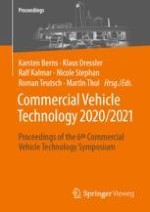Die Beiträge des Bandes Commercial Vehicle Technology 2020/2021 sind eine Sammlung von Publikationen für das 6. CVT Symposium der Commercial Vehicle Alliance Kaiserslautern. Wie in den Jahren zuvor, wurden zahlreiche Beiträge zu aktuellen Entwicklungen im Nutzfahrzeugbereich zu einer interessanten und informativen Sammlung zusammengestellt. Die Beiträge sind für Maschinenbauer, Elektrotechniker und Informatiker aus Industrie und Wissenschaft von Interesse und zeigen den aktuellen Stand der Technik auf diesem Gebiet. Die Inhalte der Publikationen umfassen die Themen automatisiertes und vernetztes Fahren und Arbeiten; Energie- und Ressourceneffizienz; Innovative Antriebe, Elektromobilität, alternative Kraftstoffe; Innovative Entwicklungen und Anwendungen; Nutzungsvariabilität, Lastdatenanalyse und Auslegungslasten; Sicherheit, Zuverlässigkeit und Lebensdauer sowie Simulationsmethoden.
The proceedings of Commercial Vehicle Technology 2020/2021 are a collection of publications for the 6th CVT Symposium of the Commercial Vehicle Alliance Kaiserslautern. As in previous years numerous submissions focusing on current developments in the field of commercial vehicles have been composed into an interesting and informative collection. The contributions are of interest for mechanical engineers, electrical engineers and computer scientists working in industry and academia and show the current state-of-the-art in this field. The contents of the publications span the topics automated and connected driving and working; energy and resource efficiency; innovative drives, electromobility, alternative fuels; innovative development and applications; usage variability, load data analysis and design load targets; safety, reliability and durability as well as simulation methods.
